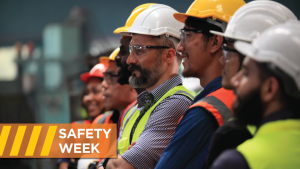With the increased demand for contractors to erect structures quicker, it is no surprise that project fast-tracking is becoming the norm rather than the exception in today’s booming marketplace.
Four speakers present views
DCN correspondent
With the increased demand for contractors to erect structures quicker, it is no surprise that project fast-tracking is becoming the norm rather than the exception in today’s booming marketplace.
The fast-track approach offers improvements over the traditional system in terms of shorter completion time, less cost overruns, project control and reduction in disputes.
That’s what an audience heard during a seminar called Designing and Building Fast-Track Projects: Techniques, Contracts, Risks at the annual Vancouver B.C. Construction Show.
Four speakers presented different perspectives on fast-tracking from the roles of owner, architect, and builder, plus legal consequences during the session.
In explaining how to achieve success and avoid failure in fast-track projects, the general consensus among the speakers was the need for expertise, collaboration and co-ordination between all parties, careful and early planning and understanding the risks.
While the traditional construction method takes place in a linear, one-step-at-a-time process, a fast-track project compresses the schedule by fast-tracking the design and construction — essentially designing and building simultaneously before the final design.
For example, said moderator Chris Quaife, principal, Symmetric Resources, you don’t need the electrical drawings to do the foundation for construction.
Not only is the design construction schedule being compressed, the industry is now looking at ways to compress the approval schedule with various municipalities, according to Don Redden, president, Redden Development/Management.
“Owners want to capture a market that is here today but may not be here in six months,” he said.
Some of the advantages of a well-executed fast-track project include better materials, less risk of project costing errors and reduced change orders.
It requires creating a teamwork environment in which all parties work together to ensure success.
Redden cited labour inflation and materials price instability as a challenge. In his 25 years in Vancouver, he has never seen such rapid price changes in the industry. It’s now very difficult to lock in prices, he said, with trades reluctant to hold prices beyond 30 days.
Escalating construction costs also mean owners want to capitalize on today’s prices rather than wait several months for working drawings, said Task Construction Management president John Hiebert.
He agreed that the fast-tracking approach is here to stay, estimating 90 per cent of Task’s projects are fast-track.
“Fast-tracking is a balance of quality, time and money,” he said. “Construction management is not for the faint of heart. Don’t give it to rookies.”
With reward, however, comes risk. Despite the benefits, explained Matti Saar, principal, M Saar Architecture, fast-tracking is fraught with risk.
“It is a risky process. And certainly the designer — architect, engineer — they are in the crosshairs of that risk,” he said.
For designers to mitigate risk, Saar recommended obtaining adequate fees to cover additional time and work and ensuring availability of staff during the process.
Quality control is important for all types of projects but especially fast-track projects.
The designer is under incredible amounts of pressure to produce things quickly and on time, said Saar, and because of the time pressure, fast-tracking tends to produce more, although hopefully small, mistakes.
Norm Streu, partner, Alexander, Holburn, Beaudin & Lang, illustrated what happens if fast-tracking goes wrong by discussing the details of a real litigation case involving a mixed commercial/multi-unit residential highrise building in Vancouver.
Using the case example, he highlighted some of the problems that occurred, including the owner’s lack of confidence in the construction manager and a lack of single-point responsibility.










Recent Comments
comments for this post are closed